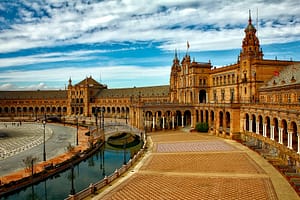Seville has a rich and fascinating history. The Romans governed the whole of Spain for more than six centuries. Their first colony was Italica which may still be visited today. The Romans changed the face of the countryside and towns, building aqueducts and long straight roads to link the major towns. But it was the Moslem civilization which was to have the most lasting impact on the city. Their reign lasted for nearly 800 years in Andalucia from 711 until 1492 when the Catholic monarchs defeated the Moslem kingdom of Granada.
Some of the city’s most magnificent buildings stand as a legacy to this era, including the Torre del Oro, Torre de Plata, Giralda, Patio de los Naranjos, the area of Triana, the Macarena Walls and the Alcazar. Later the the mudejares used their skill to create beautiful Moorish-style buildings, such as the Palacio Pedro 1, part of Seville’s Reales Alcazres. There are several Mudejar churches dating from this period, including the Iglesia de San Marcos, the Iglesia de Santa Catalina and the Church of San Pedro.
Interestingly, Mudejar architecture continued long after the Moslem period, one of the best examples being the Casa de Pilatos, one of the most beautiful buildings you can visit in Seville. The city walls and gates offer an insight into the history over the ages. After the fall of Granada to the Christians, Spain entered an era of expansion and prosperity. The conquest of the New World made Seville one of the most affluent cities in Europe, but much of this wealth was squandered on wars by the Hapsburg kings. The 13-year War of the Spanish Succession saw Bourbons on the throne in place of the Hapsburgs and, under the Treaty of Utrecht, the loss of Gibraltar to the British. Later ties with France dragged Spain into the Napoleonic Wars.
Following the Battle of Trafalgar, the Spanish King, Carlos 1V abdicated and Napoleon Bonaparte placed his brother, Joseph on the Spanish throne. The Peninsula War ensued and, with British help, the French were driven out of Spain. After the Bourbon restoration, Spain weakened by further strife, began to lose her colonies. By the 18th century, Spain had fallen into economic decline and in the 19th and early 20th centuries poverty led to political conflict and ultimately to civil war.
In 1992 this event was repeated when Expo took place again in Seville, attracting thousands of visitors from around the world. Its mixed architecture and celebrated flamenco make Andalucía’s largest city one of passion, history and irresistible charm. Home to Moorish monuments, fine art, flamenco, endless festivals and the world’s largest Gothic cathedral, Seville is a city of passion where matadors and cantadors still make their mark.

